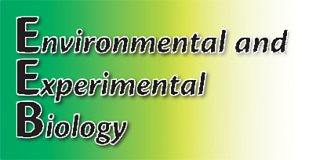
On-line: ISSN 2255–9582

| Faculty of Biology, University of Latvia | ||||||

|
Hard copy: ISSN 1691–8088
On-line: ISSN 2255–9582 Env Exp Biol (2013) 11: 53–58
|
|||||

|
About the Journal | Retractions | Open Access | Author Guidlines | Current Issue | Archive |
|
Environmental and Experimental Biology |
Env Exp Biol (2013) 11: 53–58 |
A field experiment was conducted during the vegetation season of 2012 to evaluate the effect of nanosilver application and weed density in an integrated fertilization system on agronomic traits of soybean. The experimental design was arranged in split-split plots based on a randomized complete block design. Main plots consisted of six fertilizer resources including farmyard manure (F1); compost (F2); chemical fertilizer (F3); farmyard manure + compost (F4), farmyard manure + compost + chemical fertilizer (F5); and a control (F6). Subplots with three weed densities were 0 (D1), 10 (D2) and 20 (D3) pigweed plants m−2. Sub-subplots were seed treated with nanosilver (N1) and control (N2, without nanosilver). The results showed that coapplication of organic and chemical fertilizers (F5) increased leaf chlorophyll significantly. The highest grain nitrogen was obtained from F5D1 and D1N1 treatments. The highest grain P and K concentration was obtained from F5 treatment. Coapplication of compost, farmyard manure and chemical fertilizer produced a higher amount of pods per plant, seed number per pod and 100-seed mass. Since the highest amounts of grain yield components were obtained from F5 and D1 treatments, F5D1 produced the highest grain yield.